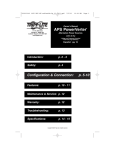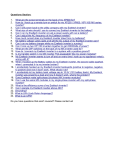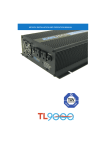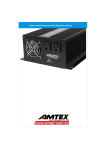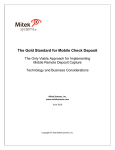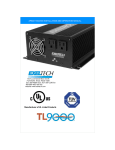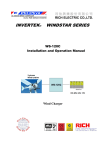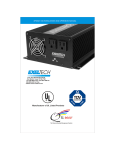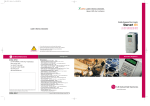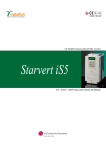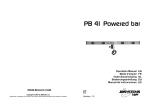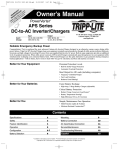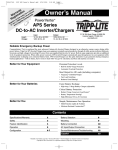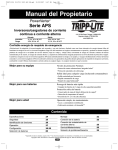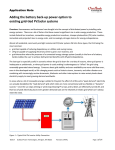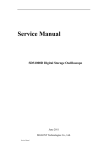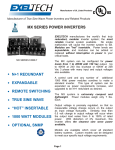Download Solar Electrical System
Transcript
Our 2012 Off-Grid Solar Electrical System – 30 Years of Evolution, by Bob Dahse
Our first home was electrically powered by a 12-volt “umbilical cord” running from the battery
in a late-60's Volkswagen Beetle to a few tiny 12-volt appliances. We would push-start and
drive the car 20 miles once each week to get supplies in town and recharge the battery. It was
a big upgrade to build our own photovoltaic (PV) panel from thirty-six, 4-inch, silicon cells from
an electrical surplus catalog. Our next home used both a recycled wind turbine from the
1930's and solar electricity from purchased PV panels. Our current current house is solely
solar powered since a nearby site that's high enough for wind is too far away to economically
transport the energy, and stream that could supply hydroelectric power is far below us in the
valley, again making the transport distance too far to accomplish without lots of expensive
copper cable and protective tubing to keep the squirrels from chewing it up.
While the up-front cost of solar electricity may be the highest of the available alternatives in
terms of cost per watt produced, it's the simplest to install, the longest lasting, and the easiest
and cheapest to maintain. When your current site is ideal for solar but not the others you have
to use what your site dictates! Below is a photograph of our only electric power source: about
1900 watts of solar power manufactured by Kyocera, one of the oldest ceramics companies
(and they aren't owned by an oil company!). To see the technical specifications on these
panels, just Click Here.
The next component in either an “off-grid”
power system, with no connection the the
local electrical network, or in a system
that maintains a renewable source of
back-up, emergency power, is batteries.
But before the energy flows to the
batteries there needs to be some
protection added to the system to ensure
that a nearby lightning strike doesn't
travel into your home along with the
desired renewable power. In our home
the solar power gets intercepted by this
device, a lightning arrestor. It connects to
both the positive and negative incoming
wires, and shunts any high voltage
spikes to a ground cable connected to an outdoor ground rod.
Power can be stored on-site using a
variety of battery types including the
old lead-acid, deep-cycling variety,
improved by better construction, lower
maintenance, and longer useful life
before recycling. In our current home,
we originally used four, 375 amp-hour,
6-volt batteries wired in series-parallel
configuration to obtain 12 volts and 750
amp-hours (seen above, at the left,
totaling
9.5
kilowatt-hours).
Our
batteries before that were Thomas
Edison's nickel-iron (Ni-Fe) cells using
potassium
hydroxide
electrolyte,
manufactured in the 1920's. They were
built for severe conditions and industrial
use, and could be restored by simply
changing electrolyte every 10 years. But
we switched to lead-acid mainly
because it's getting harder to find
replacements
for
mechanically
damaged Ni-Fe cells or to find additional
cells. There are Chinese models made
now, but the quality is not up to Edison's
standards! For some time we were using the set-up shown above, with lead acid wet cells
and gel cells in parallel, until the left set was removed. Now we just use the sealed lead-acid
gel batteries seen above at the right, 10 batteries, wired in parallel for 12 volts, totaling 980
amp-hours or 12.5 kilowatt-hours. The wet cells were recycled after nearly 10 years of use.
Now we have no fluids to add, no gases given off, and twice the battery service life at the
same use rate. If you would like to see the specifications of these batteries, just Click Here.
Some of what is now used for home
energy systems got its start in the
military. This is a close-up of the watersaving battery caps we used in the old
lead-acid “wet cells”. Since charging
batteries "gas off" some hydrogen and
oxygen when they're nearing full
charge, various caps have been
designed to catalytically recombine the
gases to water (HydroCaps, for
instance), or simply to condense
evaporating water (like these), in
systems that don't heavily overcharge.
This technology was originally used in
WWII submarines which surfaced to
quickly diesel-charge their batteries and generated lots of explosive gases in the process.
We also used a device designed for the
military called a "desulfator". It uses a tiny
bit of battery power to send a small highfrequency pulse back into the batteries,
hampering the growth of large lead sulfate
crystals that build up on the lead plates,
eventually leading to premature battery
failure. This rather cramped photo shows
the 2-by-2-inch device. Now that we use
sealed batteries that do not sulfate these
devices have become obsolete in our
power system.
In order to keep both the batteries, and
anything connected to them, from getting
“fried” by too much voltage or starved or
sufficient voltage to charge or power them,
there needs to be some form of regulation
for your incoming power source. In the case
of PV panels, the early models had no
internal protection from electrical “back-flow”
at night. The solution was a simple Shottky
diode mounted on a heat-sink. This worked
to keep power flowing in one direction but
still did not keep voltages in a narrow range.
To accomplish true voltage regulation we originally used this
device, a Trace C-30 Voltage Controller. It could switch the PV
power on or off, or it could shunt excess power to a “diversion
load”, such as a 12-volt water heater element, light bulbs, a 12volt refrigerator, or simple ceramic resistors (more on these
below). It worked well at this task but the frequent clicking of the
relays as voltage reached its high and low set-points became
annoying and we tried to find something a bit more sophisticated
that could charge batteries the way they were designed to be
charged, in stages of high current bulk charge, a constant
voltage absorbing charge, followed by a lower voltage float rate.
This was our next load diversion controller, a Trace C-40. It used
PWM, or Pulse-Width Modulation – a fancy form of switching the
inputs on and off at a very rapid rate, to divert the exact amount of
excessive input power that keeps the batteries at a specified bulkcharge, absorbing, or float-charge voltage. But with precision came
a nasty low-pitched electrical hum from the pulsed DC current sent
to the diversion loads. Eventually this had to go in favor of a return
to the older C-30 (black box above), and the house was quieter
both in terms of sound and electric fields. The unit was sold to
someone with a smaller PV system.
Both of these devices have been replaced by MPPT (maximum
power-point tracking) controllers from Outback, the FlexMax-80 and
Flexmax-60. They replace all of the functions of a reverse-flowpreventing diode (seen above), a load diversion controller (like the
Trace C-30), and a PWM input controller (like the Trace C-40). They
can handle up to 60 or 80 amps of power into 12 to 48-volt
batteries, maximizing the power input from the PV panels, and have
"AUX Send" output terminals to switch external power-control relays
on or off at specific voltages. This allows tight control over our
power diversion loads, including an electric water heater, 12-volt
refrigerator, electric tractor, electric mower, electric hybrid trikes, an
electric car, and an electric oven. Plus, these unit log all of the
voltage, amperage, and power statistics generated by the PV
system, available for viewing up to 128 days later. And, since they
can handle many different output voltages, they can be switched to
charge both our 12-volt household battery bank as well as the 36volt electric tractor battery and the electric car’s three 48-volt packs.
To see the manual on this product, just click here.
So, at this point power is flowing in safely and it is being stored for future use, with the excess
flowing to other appliances, devices, or vehicles that might normally be powered by nonrenewable energies. Here are some examples of these so-called diversion loads. This first
one is called a ceramic air resistor. It resists
the flow of electrical energy and gets hot in
the process. This is a useful trait if you want
to power a yogurt maker, a small oven, or
even a water heater (using a low-voltage
stainless steel water-heater element made
for the task). The resistors we use can be
found on this site, searching under “charge controls” and scrolling far down the page.
We used the 12-volt water heating element in our tiny
10-gallon water heater (right), replacing the standard
120-volt element with the low-voltage unit. The lowvoltage oven we built (below) uses four switchable air
resistors, two 0.5 ohm and two 5-ohm, to supply either
30, 60, 330, or 660 watts of heat depending on our
heating needs. One of the 40-amp, 12-volt relays that
turns these diversion loads on and off, based on control
signals coming from the Outback controller, is pictured
below and right.
Our Servel/Dometic refrigerator is a tiny unit
that holds the equivalent of about six 6-packs,
It operates from either 120-volt AC power, 12volt DC power, or from LP (liquified
petroleum, or propane) gas, though we use it
strictly as a diversion load running at 12 volts
at about 7 amps. All of these loads can be
switched automatically or chosen manually.
One of the ways in which we switch loads on or off is to use a
common electrical breaker box and Square-D brand QO model circuit
breakers, which can both safely switch AC/DC loads and act as a
resettable fuse. At the left you can see our home's DC breaker box,
and below left is our shed's entire control circuitry, switching power
manually or automatically from six PV panels to either a 12-volt
mower, a 36-volt DC garden tractor, three 48-volt battery banks in our
electric Porsche 924, or, as 12-volt, power to our house. The entire
wiring plan for
the shed is
illustrated
below.
And shown here
are DC switches
that choose the
refrigerator
or
the hot water heater, either in manual
or auto modes.
But what about devices that run on “normal”
120-volt AC power, you may ask? Well, Our
"critical" electrical devices (water pump, lighting,
flour mill, radio) run directly from the batteries on
12-volt DC. Previously, our conventional 120volt appliances ran from the Exeltech XP1100
sine-wave inverter pictured below right. Turning
12-volt DC into 120-volt AC, this inverter easily
handled all of our household loads (anything
under 1100 watts, or about 9 amps of AC)
but was too small to use with our electric
chainsaw or our electric car charger. For
these we could use the much larger 3600watt, “modified-sine-wave" (more on this
below) inverter (Tripp-Lite APS3636VR)
mounted on our electric tractor, which can
power two separate 15-amp AC circuits.
But we now use this 1800-watt Statpower
(Xantrex) sine-wave inverter that replaced
the Exeltech in our house. We can now
operate at least one full 15-amp AC circuit
either indoors, in the shed, or outdoors.
Many homes that utilize renewable energy for their electrical needs are wired for both lowvoltage DC and standard AC loads. But, since humans are quite sensitive to AC electric and
magnetic fields, the inverter is switched on only when AC loads are being operated. We use
switched outlets at each appliance location and where a device uses a "black box" or "wall
wart" to change voltage or switch from AC to DC current, we use additional labeled wall
switches to activate only the intended device. This eliminates "phantom loads," energy
sucking, unintended drains on an otherwise intentional, clean, and efficient electrical system.
Since electric fields drop as voltage goes down, 12-volt lighting and appliances are an
attractive option where low-power, low-amperage devices can be used. In high-amp loads like
big motors or water heaters, the increased magnetic fields these produce can offset any gains
made from lowering voltage, unless those loads are far from the main living spaces. In our
home, all of the lighting is 12-volt DC. We used to have a few 12-volt compact fluorescent
lamps that converted 12 volts of DC to roughly 10,000 volts of AC in the bulb's "ballast" (a tiny
inverter). This created a moderately-sized electric field "no-man's-land" around the fixtures as
a trade-off for one-fifth the energy use. We have since converted all of our lighting to 12-volt
L.E.D. (light emitting diodes) bulbs. For more detail, check our EMF Hazards web page.
Another factor that can reduce or eliminate AC electric/magnetic field exposure is the
"sensible" use of an inverter in renewably-powered homes. If the home is not connected to
the Grid (by using a grid-intertie inverter), the "stand-alone" inverter turns low-voltage DC
from storage batteries into "line-voltage" AC for standard appliances. Since many AC loads
can be eliminated by using DC devices wherever possible, the inverter often doesn't have to
be running all of the time! And if an inverter should break down (unlikely, but there's always a
lightning strike!), powering essential loads direct from battery DC is great insurance.
Older and cheaper "square-wave" and "modified sine-wave" inverters rapidly and abruptly
switch voltage levels to create a "choppy" sort of AC that only roughly approximates gridproduced AC. The modern "sine-wave" inverter produces a smoother, wave-like pattern of
increasing and decreasing AC voltage that most electrical devices prefer. Not only do motors
run cooler on sine waves, but the transformers found in many audio-visual devices and "wall
warts" no longer hum. Sine-wave inverters can (at least with some modification) actually
produce "cleaner" power than what's found on the grid. Grid-produced AC often has voltage
spikes, or dips (requiring the use of surge suppressors) and high-frequency "harmonics" (or
"hash") and "transients" (or "spikes") that have additional negative health consequences. But
even the best sine-wave inverters also generate harmonic frequencies and internallygenerated switching frequencies. What to do about it?
Some inverters constantly check for switched-on loads and turn themselves on only when
called for (the Search Mode). And as stated earlier, in our home each cluster of AC outlets
has an inverter switch to turn the AC power on only when it's needed. Either way, this
eliminates inadvertent AC electric field exposure since no AC is being sent through the wiring
most of the time. The Stetzerizer Filters I mention on our EMF Hazards web page don't work
well on some inverters. A couple of inverters that seem to be unbothered by the capacitive
filtration of the Stetzer filters are the Xantrex {Statpower} Pro-Sine series (seen on the
previous page) and the Xantrex SW series.
This is a Graham-Stetzer capacitive filter, composed
of a small motor capacitor, a resistor to discharge the
capacitor when it is unplugged, a couple of tabs to
plug it in, and a plastic case. This one has been
modified by adding an aluminum screen around it
which gets grounded to the center screw on the outlet
face-plate, shielding the home's occupants from highfrequency electric fields that radiate from the
capacitor's outer shell. I've
contacted
the
manufacturer about this problem (including electric
field readings before and after alteration) and received no response, but this rig works well on
some inverters.
But by contacting your inverter's manufacturer,
the technical staff may be able to build a
frequency-targeted filter specifically designed to
remove the unwanted frequencies the unit
generates. We did this with a call to Exeltech for
our XP1100 inverter. At right is what they sent. We
wired it into the inverter's output and enclosed it in
a metal box to shield its fields. The Exeltech sees
the capacitor in a Graham-Stetzer filter as a
challenge to put the voltage and amperage back
in synch. This makes for a very unhappy inverter.
The solution from Exeltech is lots of induction and
very little capacitance. This creates a large localized magnetic field, so the filter they sent is
enclosed in a heavy steel box that blocks most of the field. Our newer 1800-watt inverter
allows us to use ordinary capacitive filters like the “Stetzerizer”.
That's about it for the moment. We really like having a bit too much PV power on sunny days,
just to make sure we have enough on cloudy ones. It gets used to replace lots of nonrenewable propane for cooking and water heating, and it keeps our leftovers chilled for reuse.
The only improvement at this point would be adding some diversity to our renewable energy
inputs, such as a small wind turbine, even though it would be costly in terms of wire length
and we don't really need more energy. But when the sun doesn't shine it's often windy, and
folks with stream power to harvest often have a very constant day/night energy supply.










